Friday, June 25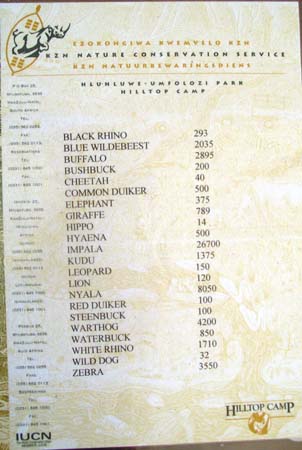
Steve: This was our first full day of game watching on our own, and we spent it inside the Hluhluwe Nature Reserve. This is one of the largest nature reserves in South Africa covering nearly 1,000 square miles. It's also world-renowned for its rhino conservation program, and we were hoping for the opportunity to see rhinos up close.
Nature reserves differ from national parks in that they have fences around their borders, and they actually buy and sell animals among themselves. Some animals, such as leopards and warthogs, can't be fenced in because of their ability to either jump over or dig under the barriers. The main road in Hluhluwe is tarred, but most of the prime wildlife viewing occurs on the gravel roads that loop off in several directions. Given the huge size of the reserve and lack of other vehicles that we saw today, our original concerns about Hluhluwe feeling too much like a zoo became largely unfounded. We were also impressed by the large number of animals that reside here - the counts are actually posted at Memorial Gate where we entered.
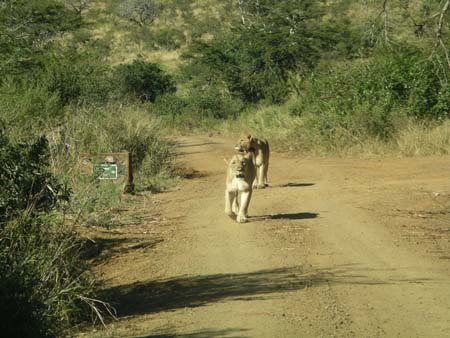 Our
first animal sighting actually was one of the best of the day. We rounded
a corner along a dirt road, and were startled to see two large lionesses walking
directly toward us. As Paula shouted "close the windows, close the windows!",
we watched as these large cats approached us and walked right next to the
car. As Katie said, they were close enough for us to reach out and touch them
(we decided not to…). They hung around the car for a few minutes, before
settling down to rest in some shade by the road. There are only 120 lions
at Hluhluwe, and we were fortunate to have seen this pair since we had been
told that the lions here are often difficult to see.
Our
first animal sighting actually was one of the best of the day. We rounded
a corner along a dirt road, and were startled to see two large lionesses walking
directly toward us. As Paula shouted "close the windows, close the windows!",
we watched as these large cats approached us and walked right next to the
car. As Katie said, they were close enough for us to reach out and touch them
(we decided not to…). They hung around the car for a few minutes, before
settling down to rest in some shade by the road. There are only 120 lions
at Hluhluwe, and we were fortunate to have seen this pair since we had been
told that the lions here are often difficult to see.
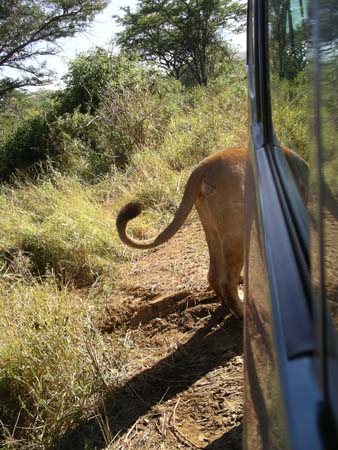
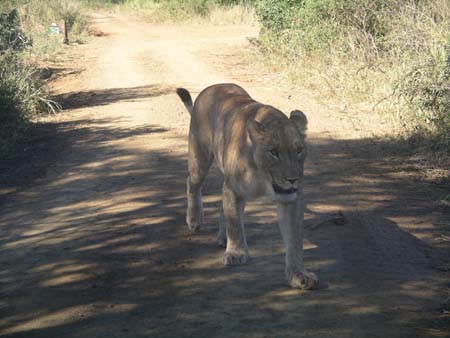
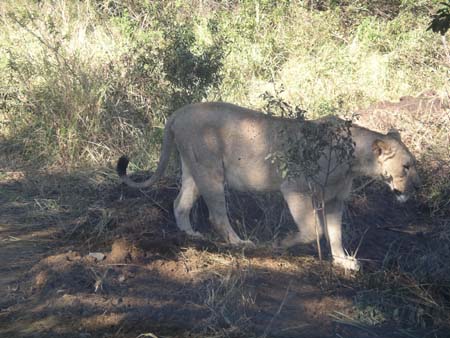
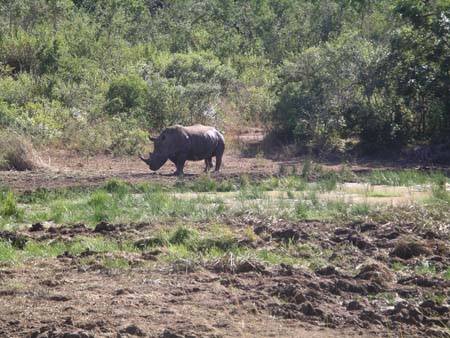
The other main highlight of the day was seeing several large white rhinos,
many at close range. Rhinos are much more plentiful in South Africa than in
Tanzania, where there are only 12 in the entire Serengiti and another 16 in
Ngorongoro Crater. Hluhluwe holds 1,710 white rhinos and another 293 black
rhinos, so we knew our chances were pretty good today. The first rhino (white)
was by himself in a large watering hole, and we enjoyed watching 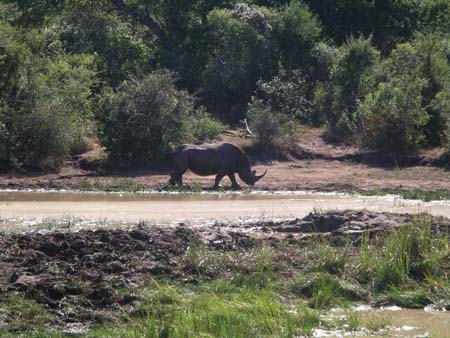 him
slowly walk around, often stopping to scratch his large horn against logs
Our next sighting was a pair of white rhinos walking in the road directly
ahead of us. Other than Paula's extreme nervousness at being charged, this
was a wonderful opportunity for us to see these huge animals up close. Toward
the end of the day, we saw another six rhinos grazing lazily in grasslands
near the same spot where we had seen the lions this morning. Counting another
solitary grazer that we saw a little earlier, that made a total of 10 rhinos
for the day - not too bad!
him
slowly walk around, often stopping to scratch his large horn against logs
Our next sighting was a pair of white rhinos walking in the road directly
ahead of us. Other than Paula's extreme nervousness at being charged, this
was a wonderful opportunity for us to see these huge animals up close. Toward
the end of the day, we saw another six rhinos grazing lazily in grasslands
near the same spot where we had seen the lions this morning. Counting another
solitary grazer that we saw a little earlier, that made a total of 10 rhinos
for the day - not too bad!
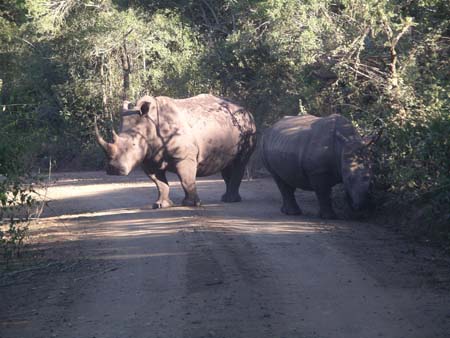
It was also fun to see large herds of buffaloes near the road, nyala, and several zebras that let us park right next to them. The zebras are called "Birchell's Zebras", a different species from the common zebras of Tanzania.
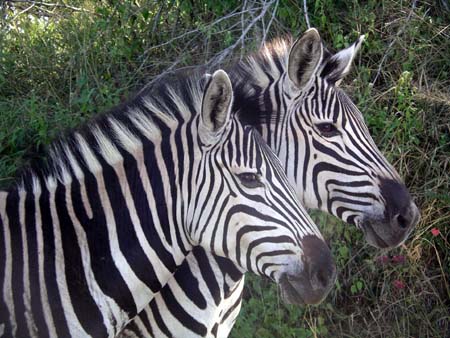
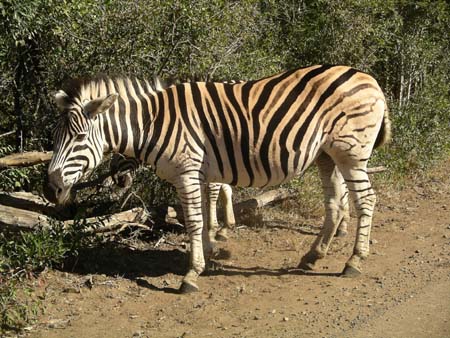
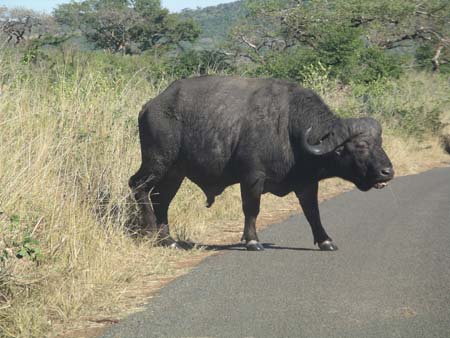
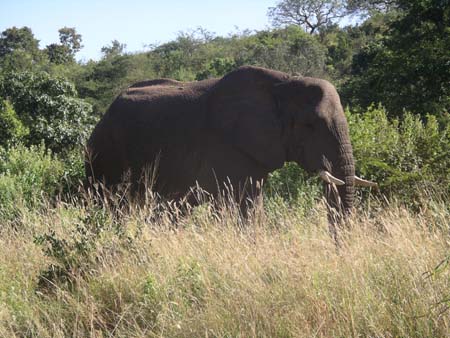
Our final adventure involved a large herd of breeding elephants that we encountered several times on the road during the late afternoon. There are warnings posted all over the park advising cars to keep a safe distance from the elephants. Apparently there have been several incidents where elephants have charged at vehicles, the most recent being last week and involving a Mercedes! This never seemed to be a major concern in Tanzania, so we assume that for some reason the elephants of Hluhluwe are simply more irritable.
In any case, we didn't want to take chances so we made sure not to approach any of the elephants too closely. This meant that we found ourselves having to wait patiently several times as big herds, complete with babies and their large and highly protective mothers, meandered leisurely in the road ahead of us.
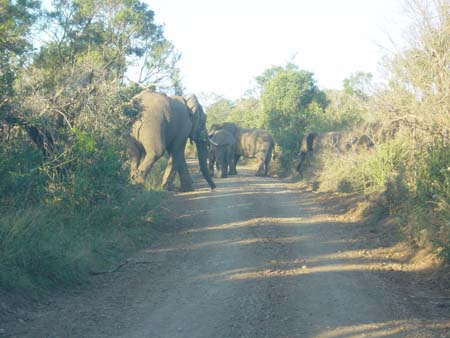 We
seemed to encounter one very large herd of at least 15 elephants multiple
times, which wasn't really a problem until late in the afternoon when we were
trying to get out of the park. It was 5:30PM, and we had just completed our
final loop along a dirt road, ready to take the main way back to Memorial
Gate before the reserve closed at 6:00. Right as we got ready turn onto the
tar road, we saw the herd again, this time directly in front of us and blocking
our way. It was starting to get dark, and we now had a difficult decision
to make. Do we wait out the elephants, hoping that they'll move safely out
of the way in time for us to make it back, or do we backtrack and take a long
detour on gravel roads that eventually would take us to Memorial Gate? Even
if we backtracked, there was always the risk of encountering more elephants,
which would really be a big problem…
We
seemed to encounter one very large herd of at least 15 elephants multiple
times, which wasn't really a problem until late in the afternoon when we were
trying to get out of the park. It was 5:30PM, and we had just completed our
final loop along a dirt road, ready to take the main way back to Memorial
Gate before the reserve closed at 6:00. Right as we got ready turn onto the
tar road, we saw the herd again, this time directly in front of us and blocking
our way. It was starting to get dark, and we now had a difficult decision
to make. Do we wait out the elephants, hoping that they'll move safely out
of the way in time for us to make it back, or do we backtrack and take a long
detour on gravel roads that eventually would take us to Memorial Gate? Even
if we backtracked, there was always the risk of encountering more elephants,
which would really be a big problem…
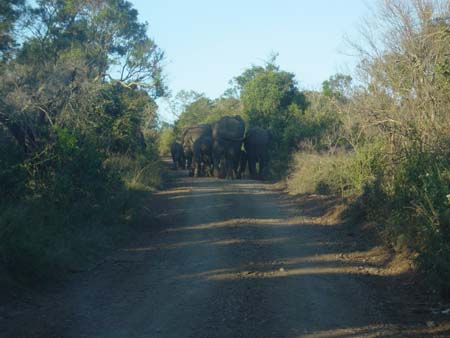
We waited for about five minutes, watching to see what the elephants were doing. Even after we tried honking the horn and flashing our lights it was clear that the elephants were in no hurry to go anywhere, and seemed to like being on the road. They tantalized us a couple of times by walking briefly into the forest, but then reappeared often gazing at our car as if they knew exactly what they were doing to us. The darkness was setting in quickly, and we all became very worried with visions of spending the night locked in our car inside the park and its collection of wild animals.
Finally we made the decision to turn around and take the long gravel road that we knew at least for the moment was clear. I told everyone to hold on and drove as fast as I could, hoping all the time that no huge rhinos or buffaloes would decide to cross in front of us. Fortunately, and to our great relief, the drive took much less time than we had feared, and we made it back to Memorial Gate with a good fifteen minutes to spare. Oh, and did I mention that the whole time our gas gauge was almost on empty? Enough excitement for one day…
Tomorrow we have decided to forgo another day of wildlife viewing for a day of relaxing and enjoying the scenery around the Zulu Nyala Game Lodge where we are staying. Sunday we have a very long drive through Swaziland and up to Kruger National Park, so a day of rest will do us good.
Animals seen today:
Warthog
Impala
Buffalo
Lion (2)
Elephant
Nyala
Wildebeest
Birchell's Zebra
Hippo
White Rhino (10)
